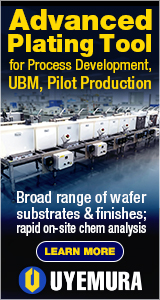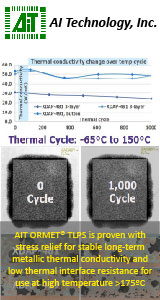|

|
|
| Ask the Experts | |||||||
|
|||||||
|
January 15, 2007 - Updated July 4, 2007 - Originally Posted Solder alloy functionWe are using solder wire and solder paste for die attach process. The solder composition is Pb/Ag/Sn for lead base solder and for J-alloy solder is 65Sn/25Ag/10Sb. I would like to understand what the function is of each element (Pb, Sn, Ag, Sb) in solder. J.L. |
|||||||
| Expert Panel Responses | |||||||
|
The main reasons for choosing particular alloying elements are performance (mechanical reliability, melt point, etc) and cost. If we analyse the intermetallic layers formed during soldering it turns out that all of them contain Sn. Consequently Sn can be thought of as the active ingredient of solder irrespective of the other metals present. The addition of a second metal (Pb) will result in a decrease in the liquidus point of the alloy until the eutectic point is reached ( at this point the alloy has a sharp melting point rather than a solidus and liquidus temperature see phase diagram) further addition of the second metal will then start to increase the liquids temperature. Thus Pb may be considered as a dilutant that reduces the melt point from 232 C for pure Sn to 183 C at the eutectic point. It is also convenient that Pb is a very cheap metal and also reduces the overall cost of the alloy. The Pb also confers additional ductility to the alloy. The addition of Ag to Sn Pb not only reduces the melt point but also increase the bulk creep resistance, the bulk ultimate tensile strength, and the bulk shear strength. In the case of the Sn, Ag, Sb apart from increasing the melt point it is also considered to make the joint stronger.
Senior Applications Chemist Henkel Electronics Dr. Poole is a Senior Applications Chemist in Henkel Technologies, electronics assembly materials application engineering group. He is responsible for all of Henkel's assembly products including soldering products, underfills, PCB protection materials, and thermally conductive adhesives.
Your question is very involved and can not be answered in a simple paragraph or even a book. However some basics are: Sn is the active metal that wets and forms an intermetallic layer with your base metal. This gives the bond strength. Ag also helps some for wetting however in Alloy J silver forms an intermetallic structures with Sb and give the alloy its ridged hard structure. Sb works to reduce surface tension however it oxidizes rapidly so high Sb solders are normally sluggish in flow. Pb is a great element for solder until someone decided to ban it in many applications. It is relatively inert, forms a nice eutectic with tin, is malleable and all round a very good reliable solder but does not wet well on its own. Normal elements to aid lead solder wetting are Sn and Ag. Sb is used to harden lead and Sn alloys as well. Hope this helps some.
Deck Street Consultants In his 32 years of industry experience, Mr. Seelig has authored over 30 published articles on topics including lead-free assembly, no-clean technology, and process optimization. Karl holds numerous patents, including four for lead-free solder alloys, and was a key developer of no-clean technology.
|
|||||||
| Submit A Comment | |||||||
|
Comments are reviewed prior to posting. You must include your full name to have your comments posted. We will not post your email address. |
|
Free Newsletter Subscription
Circuitnet is built for professionals who bear the responsibility of looking ahead, imagining the future, and preparing for it. Insert Your Email Address |
|

|



